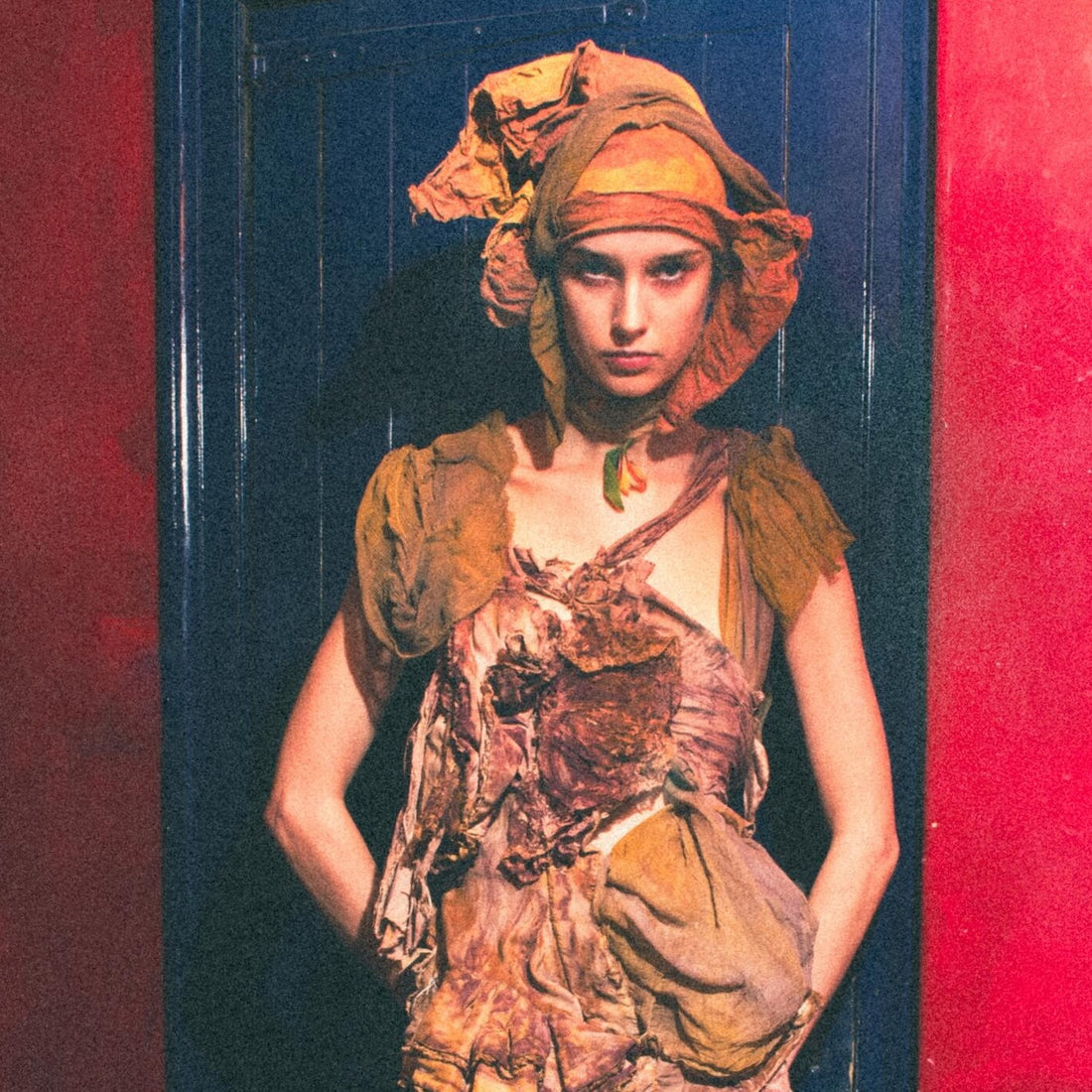
Dirty Looks: Fashion Finds Beauty in the Mud at the Barbican
At first glance, dirt seems like fashion’s enemy—something brushed away before stepping into the studio. Yet Dirty Looks: Desire and Decay in Fashion, open now at the Barbican Art Gallery until 25 January 2026, invites us to reconsider. This bold exhibition proposes that decay is not the end of beauty but the beginning of transformation. Through over a hundred garments and installations from more than 60 designers, it explores how fashion has embraced the raw, the weathered, and the imperfect as expressions of rebellion, resilience, and renewal.
The exhibition traces its roots to the anti-establishment currents of the 1980s, where designers such as Vivienne Westwood and Malcolm McLaren challenged elitist ideas of luxury, turning rips, stains, and scuffs into statements of social defiance. In parallel, visionaries of the avant-garde, namely Issey Miyake, Rei Kawakubo, and Yohji Yamamoto, introduced aesthetics shaped by wabi-sabi philosophy, honouring impermanence and patina over gloss and precision.
 Hussein Chalayan, The Tangent Flows, 1993. Photograph by Ellen Sampson.
Hussein Chalayan, The Tangent Flows, 1993. Photograph by Ellen Sampson.
A pivotal moment in this journey is Hussein Chalayan’s The Tangent Flows (1993), where garments were buried in a friend’s London garden alongside iron filings. Unearthed months later, stained by rust and earth, their altered forms embodied a poetic cycle of creation, decay, and rebirth, something that Chalayan would later call “future archaeology”.
 Paolo Carzana, Spring/Summer 2025, How to Attract Mosquitoes. Headwear and creative consulting by Nasir Mazhar. Styling and creative consulting by Patricia Villirillo. Photograph by Joseph Rigby. Courtesy of Paolo Carzana.
Paolo Carzana, Spring/Summer 2025, How to Attract Mosquitoes. Headwear and creative consulting by Nasir Mazhar. Styling and creative consulting by Patricia Villirillo. Photograph by Joseph Rigby. Courtesy of Paolo Carzana.
From soil-streaked garments to bogcore, the aesthetics of decay have evolved from shock tactics into deeper meditations on ecology, identity, and craft. Emerging designers featured in the exhibition include Paolo Carzana, Solitude Studios, Elena Velez, Alice Potts, Michaela Stark and Yaz XL, who continue this exploration, using organic materials, ritualistic processes, and speculative narratives to imagine futures rooted in regeneration. In their hands, mud becomes a metaphor for grounding; rust, a record of time; and salvage, a form of resistance against fashion’s wastefulness.
 IAMISIGO, handwoven raffia-cotton blend look dyed with coffee and mud, Shadows, Spring/Summer 2024. Photograph by Fred Odede. Courtesy of IAMISIGO.
IAMISIGO, handwoven raffia-cotton blend look dyed with coffee and mud, Shadows, Spring/Summer 2024. Photograph by Fred Odede. Courtesy of IAMISIGO.
Global perspectives play a significant role. Nigerian designer Bubu Ogisi (IAMISIGO) reclaims indigenous textile practices to reconnect with land severed by colonialism, while Ma Ke’s Wuyong/The Earth collection transforms discarded materials using rural Chinese craft techniques. Collectively, these works challenge Western hierarchies of value and celebrate humble materials as carriers of memory and meaning.
 Yuima Nakazato, Couture Spring/Summer 2023 INHERIT. Photograph by Morgan O’Donovan.
Yuima Nakazato, Couture Spring/Summer 2023 INHERIT. Photograph by Morgan O’Donovan.
Designed by Studio Dennis Vanderbroeck, the exhibition environment itself engages in dialogue with decay, setting pristine gallery walls against intentionally distressed surfaces. It is a reminder that beauty often resides in contradiction.
As Barbican Head of Visual Arts Shanay Jhaveri notes, Dirty Looks is not just about the aesthetics of ruin—it’s about “the regenerative power of making in a world in flux.” For lovers of textiles and craft, this exhibition offers a timely reflection: sometimes, to create something truly meaningful, we must first get our hands dirty.
-
Further Information:
Dirty Looks: Desire and Decay in Fashion is on until 25 January 2026, at the Barbican Art Gallery, London.
-
Image Credits:
Lead: Paolo Carzana, Autumn/Winter 2025, Dragons Unwinged at the Butchers Block. Photograph by Joseph Rigby. Courtesy of Paolo Carzana.
All further images as credited in photo captions.
